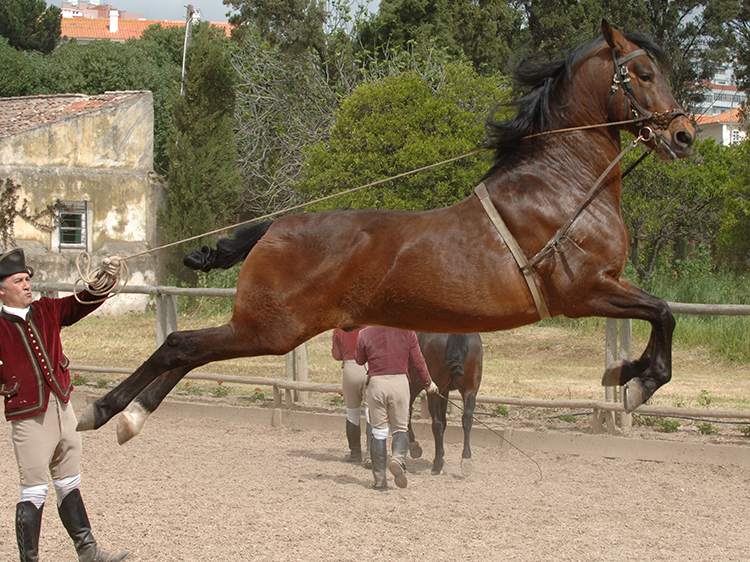
Working in the pillars, the director of the Royal School, Filipe Graciosa
Story – Christopher Hector & Photos – Roz Neave and archives
It’s been five hundred years or so, since the Pope divided the world between the two super-powers of the time, Spain and Portugal, and since then, Portugal has lost its once great empire and tends to be a bit overshadowed by Spain, its noisier neighbour to the east.
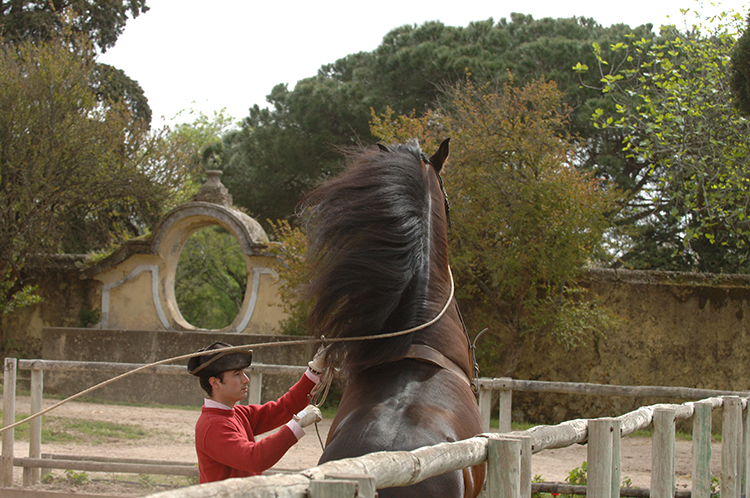 And that is a pity, since Portugal has much to offer. Not just to the tourist intent on enjoying the natural splendour of the coast and countryside, or the fabulous food and wine, the friendliness of the locals and the glory that is Lisbon, but the equestrian tourist will find much that is old and different, and much that is at the cutting edge of today’s dressage world.
And that is a pity, since Portugal has much to offer. Not just to the tourist intent on enjoying the natural splendour of the coast and countryside, or the fabulous food and wine, the friendliness of the locals and the glory that is Lisbon, but the equestrian tourist will find much that is old and different, and much that is at the cutting edge of today’s dressage world.
We were, of course, uniquely privileged in that our dear friend Miguel Tavora had lined up his old mates to take care of us – which they did with typical understated Portuguese grace…
Miguel’s brother-in-law, Joao Trigueiros de Aragao was our first minder, escorting us to the Palace of Queluz, home to the Royal School of Portuguese Equestrian Art. Sadly while most of the world knows of the Cadre Noir in Saumur, and all the world knows about the Spanish School in Vienna, and a fair number even know about the Royal School of Andalusian Equestrian Art in Jerez, the Portuguese School is one of those little neglected treasures.
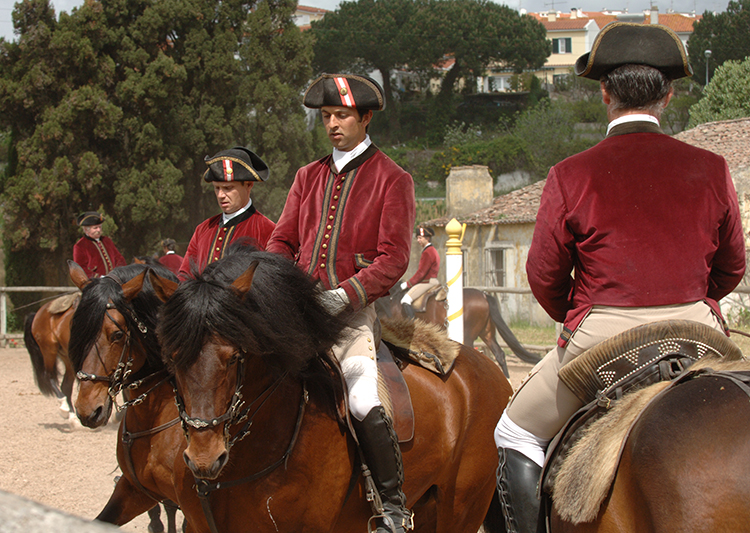
The director is the commanding figure of Filipe Graciosa – he like our guide, Joao, studied from that great master of equitation, Nuno Oliveira and proudly carries on that tradition. The school was founded by another great master, Dr Guilherme Borba who with Filipe’s help, set up the School of Jerez in Spain.
It’s early Spring when we arrive, the riders are still working out the back – in another month or so, the public performances will be underway and they will be out in front of the palace.
Terre à Terre – an amazing movement to watch, look at the background to see what’s happening, it was incredibly beautiful and peaceful to watch…
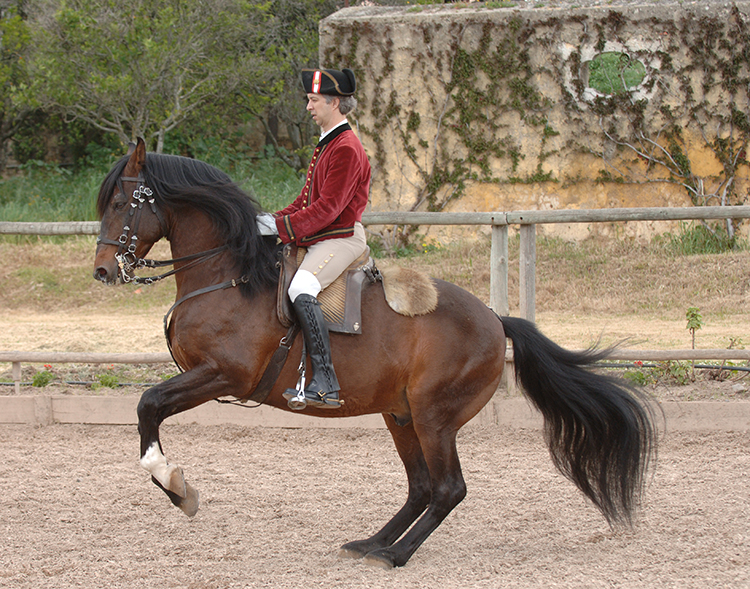
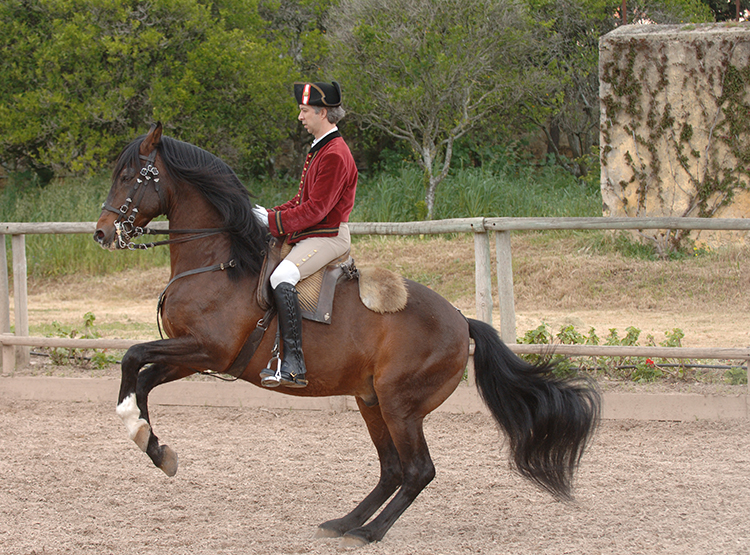
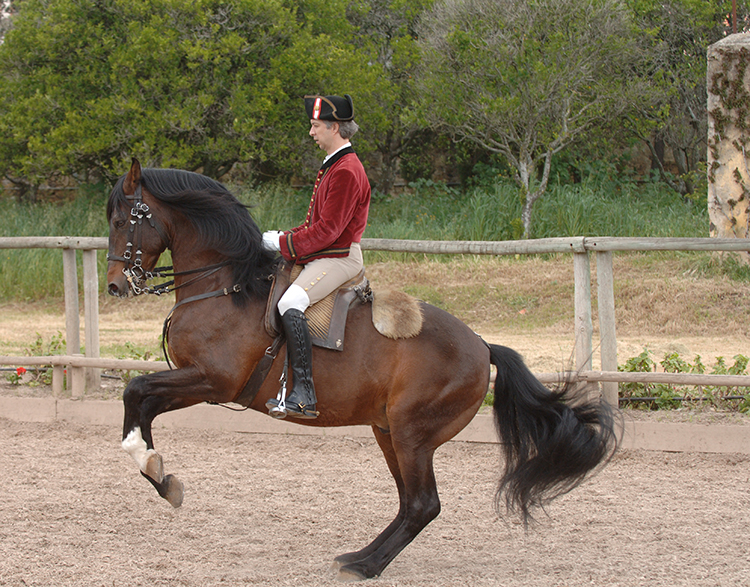
Bred at the Alter Real, or Royal Stud (founded in 1748 and the oldest stud in the world), the horses are all brown – and all very much of a type. Balanced horses, horses with weight and strength behind, horses for whom the highly collected movements come easily. Here the old traditions are respected – here the aim is to ride the horse one handed in the manner of François Robichon de la Guerinière, and the first great equestrian master, would no doubt find himself quite at home in the School.
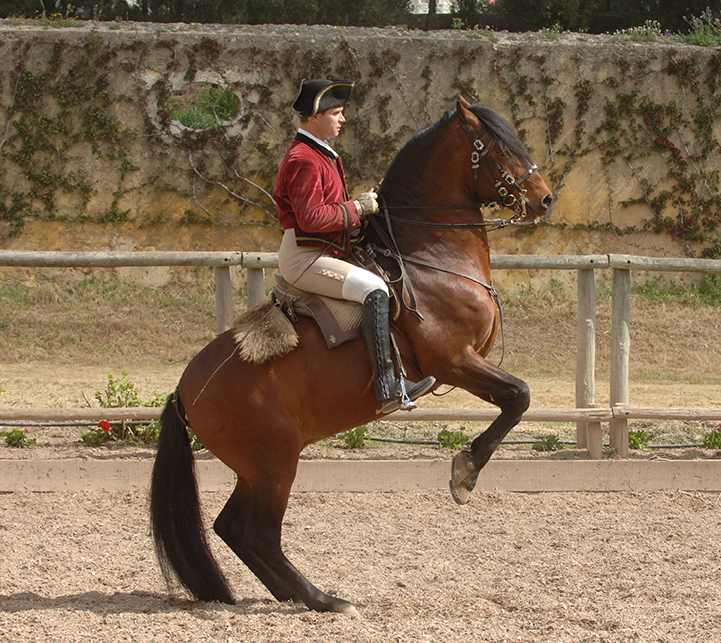
The elegant Levade
The horses are still worked in the pillars, and movements like the levade, capriole and terre à terre, still part of the daily work. I’ve never seriously watched the levade being schooled before, but it is an extremely elegant movement, as the horse gently rocks its centre of gravity to the rear and effortlessly rises. The capriole I guess we have all seen, but seldom executed as well as it is here, and the terre à terre is amazing , both hind legs together and equal, the canter diagonal broken, like an electric rocking horse.
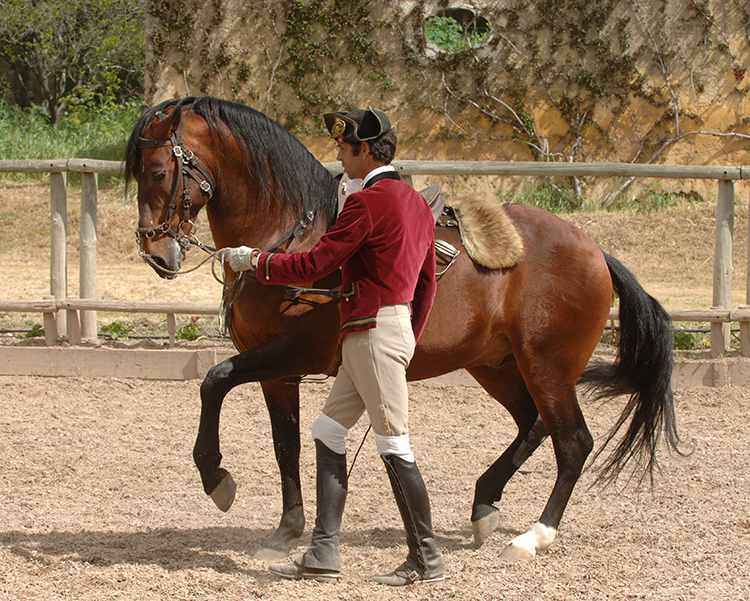
They finish with an elegant quadrille, and we can only imagine what it must be like out the front, with the music – but the real feat of imagination would be to place it in its rightful home – the Royal Riding Hall in the centre of Lisbon. Right now the Hall houses a magnificent collection of carriages but they could easily be moved to an annex, and the performances of the Portuguese School in the most magnificent riding hall in the world, would surely bring adoring fans from all over to see a baroque style of riding that is as elegant as it is timeless.
Read on about the Portuguese tradition…
The Portuguese Tradition
Unlike the horsemen of northern Europe with their heavy horses and heavier armour, the Iberian horsemen developed the fast, agile Gineta style of riding, and in the 15th century, the Spanish cavalry proved the superiority of their style when they travelled to Italy to defend their rights over the kingdom of Naples, and defeated the heavy cavalry of France.
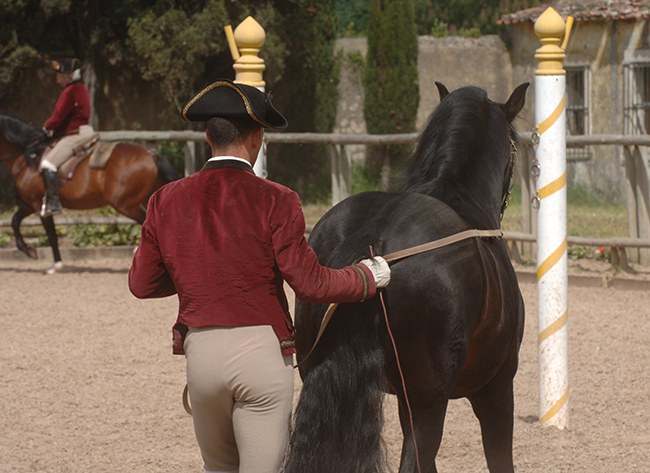
more follows

Not only did they win the battle, but they gave rise to the first of the Renaissance Riding Academies, in Naples. With the spread of this new form of horsemanship came the demand for the Iberian horses, and the new techniques, and the Iberian bloodlines, spread all over the world.
The first written work on horsemanship is credited to Xenophon (430 BC) but the second – Livo da ensinança de bem cavalgar em toda a sela, written by the Portuguese King Duarte in 1435 – has been largely ignored, with credit for the birth of the new horsemanship going to Giovanni Pignatelli, who established a riding academy in Naples, and whose pupil, Frederico Grisone published Gli Ordini di Cavalcare in 1550.
Numerous Portuguese works on the equestrian art were published in the sixteenth and seventeenth centuries, the most famous of which is Luz da Liberal e Nobre Arte da Cavallaria, published in 1790 by Manoel Carlos de Andrade.
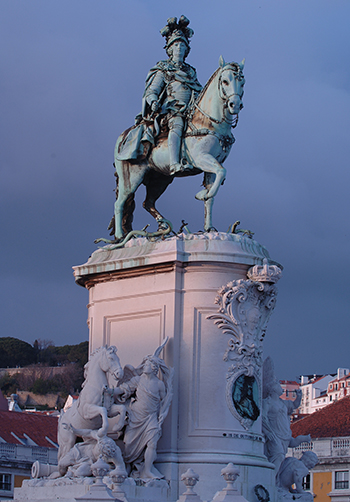
Four ‘greats’ of the Portuguese Tradition: King Duarte; The Marquis of Marialva; Mestre Miranda and Nuno Oliveira
According to Felipe Graciosa in his wonderful history Escola Portuguesa de Art Equestre (published in 2004)
“The fourth Marquis of Marialva was responsible for the technical part of the treatise. This work represents the crowning glory of an age-old tradition. The Marquis’s qualities as a riding instructor were such that, even today, the art of good horsemanship is called arte de Marialva.”
This tradition was carried on by a number of famed horsemen and bull-fighters through to the nineteenth century when the influence of Baucher and Fillis spread to Portugal. According to Graciosa:
“James Fillis inspired the great Mestre Miranda, who had a riding school in Lisbon and was the last riding master of the royal family at the riding school in Palácio des Necessidades…. He taught Nuno Oliveira… in 1940 on the death of his beloved master, Nuno Oliveira dropped out of school to devote himself to his great passion. Nuno Oliveira wrote of Mestre Miranda in 1981, ‘Of the master’s horsemanship, I remember perfectly his great discipline and the calmness and perfect submission of his horses. He was very strict. All his horses went out to do the haute école airs that they knew. The changes of step were brilliant and the fluidity of their gallop immense. The passages were excellent, with great suspension times. He died in 1940…’ We have now reached the person responsible for the embryo that would later grow into the Portuguese School of Equestrian Art. Nuno Oliveira was the horseman who impressed me the most by far. I had the honour of being his pupil every day for six years and of his being my good friend.”
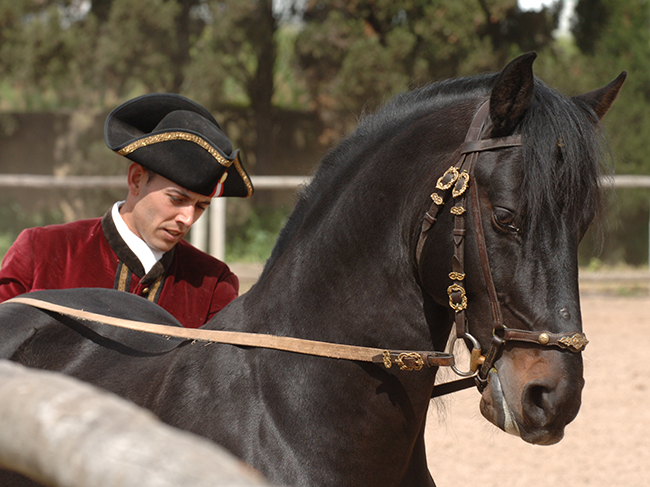
According to Filipe: “He hated monotony and being subject to a jury that did not want any surprises. His opinion was that every horse was different. He often began to ride with a lesson that he had prepared in advance, but ended up doing something completely different because the horse was not in the mood for that lesson on that particular day. His horses loved him.”
For more Go to: The Horses of Portugal – Part 2
Related Articles
2009 Lusitano DressageSeminar – Ancient Breed – New Challenge
Miguel Tavora – Thinking Horseman – Part 1 – The Young Horse
Miguel Tavora – Thinking Horseman – Part 2 – The Iberian Horse
Miguel Tavora – Thinking Horseman – Part 3 – The Young Rider
Miguel Tavora – Thinking Horseman – Part 4 – Starting FEI
Miguel Tavora – Thinking Horseman – Part 5 – Teaching Teachers
The Integration Of The Baucher System in the Classical School of de la Guérinière by Miguel Tavora
Riding as Art: Part one: A history of Dressage – Antiquity
Riding as Art: Part Two: Out of the Dark Ages
The Classical Dressage Tradition…
The Masters of the High School
Riding as Art: Part Three:
The Masters of the Nineteenth Century
Riding as Art Part Four
The Modern Training Scale: How old are our principles?



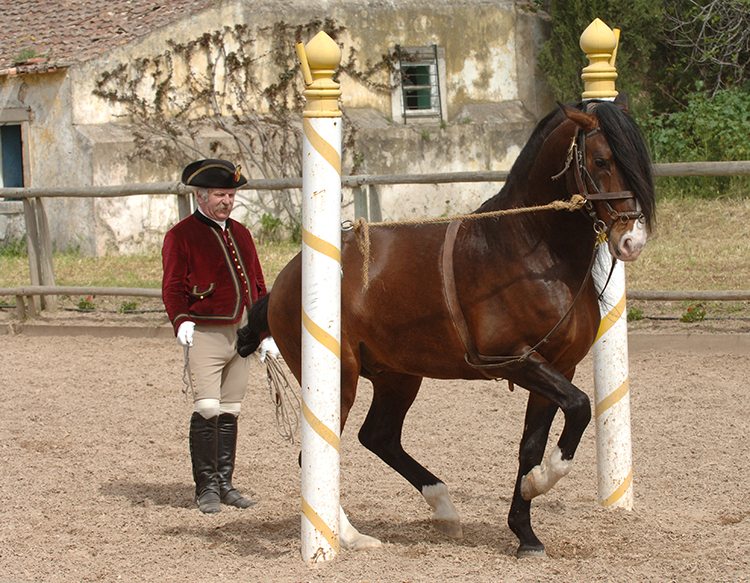
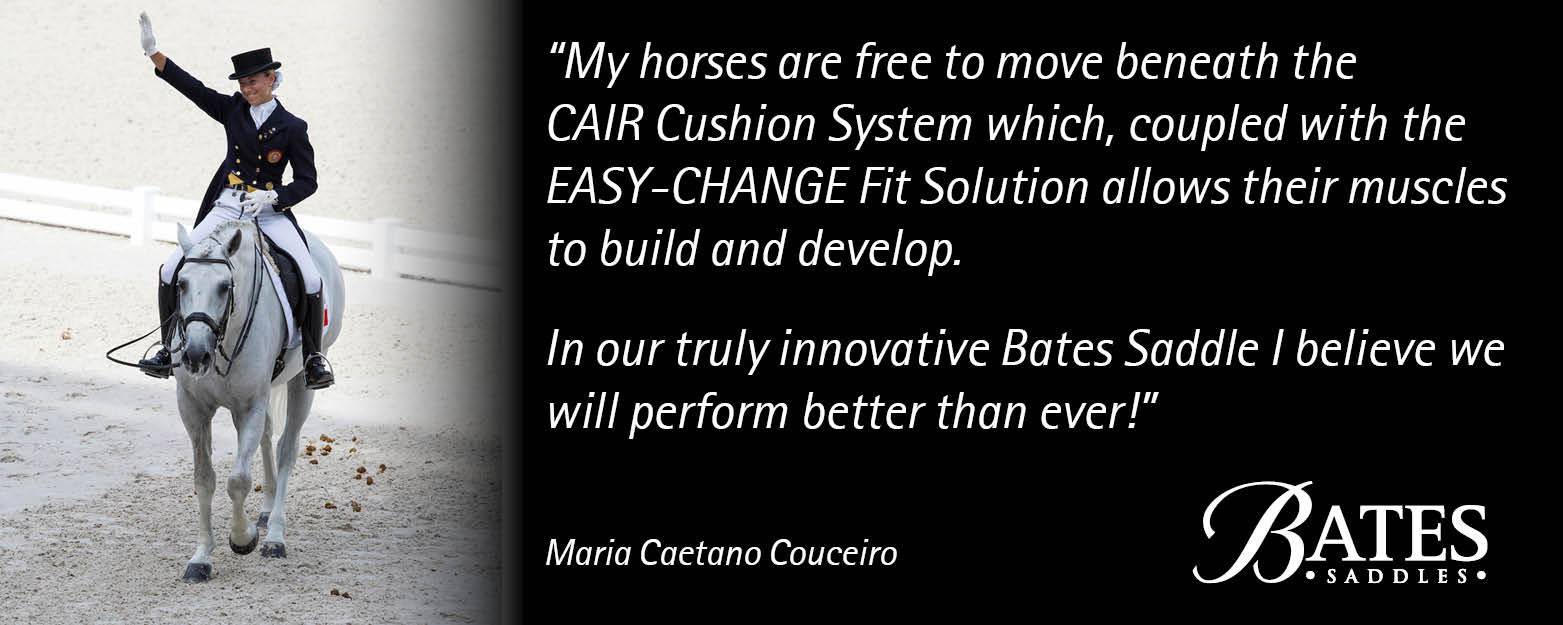
hello, i am 45, and im very much interested in learning true horsemanship in your royal school of horsemanship. i will clean stalls groom horses i’ll do what ever it takes. im a rookie polo player, and i want to learn from the best and you are the best. no one here in america like to help, they are all me, me me, it is all about them. i hope you will be able to help me. thank you for your time cheryl hall.
hello, i am 23 years, i am groom, will clean stalls groom horses and am imterested in learning Portugal’s horsemanship: traditional, classical step-by step methods. in your royal school of horsemanship. hope you will be able to help me. and thank you.